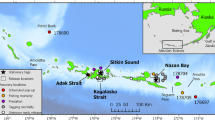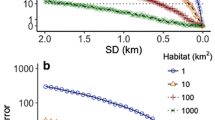Abstract
Demersal fish cannot be readily tracked using data loggers that provide satellite-based or light-based geolocation. Moreover, fish that are highly mobile within the water column cannot readily be located with other methods, such as the tidal location method (TLM). As an alternative, we describe a process that provides estimates of geographic location by simulating movement paths through geographic locations that match temperature and depth data recorded by data loggers. Depths and temperatures recorded by data loggers were compared with a North Sea temperature and depth database to identify all locations with matching data. A movement rate filter was then applied to eliminate spurious locations and simulations of possible movement paths through the remaining positions were used to generate estimates of the likelihood of a particular location having been occupied. The performance of the technique was assessed by reconstructing movement paths of artificial migrations and by using depth and temperature data collected at known locations in the North Sea. Estimates of the positional accuracy and error were comparable to the North Sea TLM. Reconstructions of the migrations of cod tagged and released in the North Sea were successfully achieved with the method. This method has application in defining the movements and migrations of commercial species in any sea area where databases of commonly measured environmental variables are available.










Similar content being viewed by others
References
Akesson S (2002) Tracking fish movements in the ocean. Trends Ecol Evol 17:56–57
Arnold GP, Dewar H (2001) The use of electronic tags in marine fisheries research: a 30 year perspective. In: Sibert J, Nielsen J (eds) Electronic tagging and tracking in marine fisheries reviews: methods and technologies in fish biology and fisheries. Kluwer, Dordrecht, The Netherlands, pp 7–64
Arnold GP, Greer Walker M, Emerson LS, Holford BH (1994) Movements of cod (Gadus morhua L.) in relation to the tidal streams in the southern North Sea. Ices J Mar Sci 51:207
Block BA, Dewar H, Blackwell SB, Williams TD, Prince ED, Farwell CJ, Boustany A, Teo SLH, Seitz A, Walli A, Fudge D (2001) Migratory movements, depth preferences, and thermal biology of Atlantic bluefin tuna. Science 293:1310–1314
Block BA, Dewar H, Williams T, Prince ED, Farwell C, Fudge D (1998) Archival tagging of Atlantic bluefin tuna (Thunnus thynnus thynnus). Mar Technol Soc J 32:37–46
Block BA, Teo SLH, Walli A, Boustany A, Stokesbury MJW, Farwell CJ, Weng KC, Dewar H, Williams TD (2005) Electronic tagging and population structure of Atlantic bluefin tuna. Nature 434:1121–1127
Blumberg AF, Mellor GL (1987) A description of a three dimensional coastal ocean circulation model. American Geophysical Union, Washington
Bolle LJ, Hunter E, Rijnsdorp AD, Pastoors MA, Metcalfe JD, Reynolds JD (2005) Do tagging experiments tell the truth? Using electronic tags to evaluate conventional tagging data. ICES J Mar Sci 62:236–246
Boustany AM, Davis SF, Pyle P, Anderson SD, Le Boeuf BJ, Block BA (2002) Expanded niche for white sharks. Nature 415:35–36
Cadigan NG, Brattey J (2003) Semiparametric estimation of tag loss and reporting rates for tag-recovery experiments using exact time-at-liberty data. Biometrics 59:869–876
Caron F, Hatin D, Fortin R (2002) Biological characteristics of adult Atlantic sturgeon (Acipenser oxyrinchus) in the St Lawrence River estuary and the effectiveness of management rules. J Appl Ichthyol 18:580–585
Davis TLO, Gunn JS, Stevens JD, Norman BM (1999) Observations on the short-term movements and behaviour of whale sharks (Rhincodon typus) at Ningaloo Reef, Western Australia. Mar Biol 135:553–559
Delong RL, Stewart BS (1991) Diving patterns of northern elephant seal bulls. Mar Mamm Sci 7:369–384
Domeier ML, Kiefer D, Nasby-Lucas N, Wagschal A, O’Brien F (2005) Tracking Pacific bluefin tuna (Thunnus thynnus orientalis) in the northeastern Pacific with an automated algorithm that estimates latitude by matching sea-surface-temperature data from satellites with temperature data from tags on fish. Fish Bull 103:292–306
Dunn MR, Pawson MG (2002) The stock structure and migrations of plaice populations on the west coast of England and Wales. J Fish Biol 61:360–393
Godo OR, Michalsen K (2000) Migratory behaviour of north-east Arctic cod, studied by use of data storage tags. Fish Res 48:127–140
Graves JE, Luckhurst BE, Prince ED (2002) An evaluation of pop-up satellite tags for estimating postrelease survival of blue marlin (Makaira nigricans) from a recreational fishery. Fish Bull 100:134–142
Gunn JS, Patterson TA, Pepperell JG (2003) Short-term movement and behaviour of black marlin Makaira indica in the Coral Sea as determined through a pop-up satellite archival tagging experiment. Mar Freshw Res 54:515–526
Hatin D, Fortin R, Caron F (2002) Movements and aggregation areas of adult Atlantic sturgeon (Acipenser oxyrinchus) in the St Lawrence River estuary, Quebec, Canada. J Appl Ichthyol 18:586–594
Hays GC, Akesson S, Godley BJ, Luschi P, Santidrian P (2001a) The implications of location accuracy for the interpretation of satellite-tracking data. Anim Behav 61:1035–1040
Hays GC, Dray M, Quaife T, Smyth TJ, Mironnet NC, Luschi P, Papi F, Barnsley MJ (2001b) Movements of migrating green turtle in relation to AVHRR derived sea surface temperature. Int J Remote Sens 22:1403–1411
Hays GC, Hochscheid S, Broderick AC, Godley BJ, Metcalfe JD (2000) Diving behaviour of green turtles: dive depth, dive duration and activity levels. Mar Ecol Prog Ser 208:297–298
Hays G, Hobson VJ, Metcalfe JD, Righton D, Sims DW (2006) Flexible foraging movements of leatherback turtles across the North Atlantic Ocean. Ecology 87:2647–2656
Hilborn R (1990) Determination of fish movement patterns from tag recoveries using maximum likelihood estimators. Can J Fish Aquat Sci 47:635–643
Horwood J, Nichols J, Milligan S (1998) Evaluation of closed areas for fisheries management. J Appl Ecol 35:893–903
Hunter E, Aldridge JN, Metcalfe JD, Arnold GP (2003) Geolocation of free-ranging fish on the European continental shelf as determined from environmental variables. I. Tidal location method. Mar Biol 142:601–610
Hunter E, Metcalfe JD, Arnold GP, Reynolds JD (2004a) Impacts of migratory behaviour on population structure in North Sea plaice. J Anim Ecol 73:377–385
Hunter E, Metcalfe JD, Holford BH, Arnold GP (2004b) Geolocation of free-ranging fish on the European continental shelf as determined from environmental variables II. Reconstruction of plaice ground tracks. Mar Biol 144:787–798
Hunter E, Metcalfe JD, O Brien CM, Arnold GP, Reynolds JD (2004c) Vertical activity patterns of free-swimming adult plaice in the southern North Sea. Mar Ecol 279:261–273
Hunter E, Buckley AA, Stewart C, Metcalfe JD (2005) Migratory behaviour of the thornback ray, Raja clavata, in the southern North Sea. J Mar Biolog Assoc UK 85:1095–1105
Itoh T, Tsuji S, Nitta A (2003a) Migration patterns of young Pacific bluefin tuna (Thunnus thynnus orientalis) determined with archival tags. Fish Bull Natl Oceanic Atmos Adm 101:514–534
Itoh T, Tsuji S, Nitta A (2003b) Swimming depth, ambient water temperature preference, and feeding frequency of young Pacific bluefin tuna (Thunnus thynnus orientalis) determined with archival tags. Fish Bull Natl Oceanic Atmos Adm 101:535–544
Kell LT, Bromley PJ (2004) Implications for current management advice for North Sea plaice (Pleuronectes platessa L.): part II. Increased biological realism in recruitment, growth, density-dependent sexual maturation and the impact of sexual dimorphism and fishery discards. J Sea Res 51:301–312
Kerstetter DW, Luckhurst BE, Prince ED, Graves JE (2003) Use of pop-up satellite archival tags to demonstrate survival of blue marlin (Makaira nigricans) released from pelagic longline gear. Fish Bull Natl Oceanic Atmos Adm 101:939–948
Laidre KL, Heide-Jørgensen MP, Dietz R, Hobbs RC, Jørgensen OA (2003) Deep-diving by narwhals Monodon monoceros: differences in foraging behavior between wintering areas? Mar Ecol Prog Ser 261:269–281
Lawson GL, Rose GA (2000) Seasonal distribution and movements of coastal cod (Gadus morhua L.) in Placentia Bay, Newfoundland. Fish Res 49:61–75
McDonald TL, Amstrup SC, Manly BFJ (2003) Tag loss can bias Jolly-Seber capture-recapture estimates. Wildl Soc Bull 31:814–822
McFarlane GA, Beamish RJ (1990) Effect of an external tag on growth of sablefish (Anoplopoma fimbria), and consequences to mortality and age at maturity. Can J Fish Aquat Sci 47:1551–1557
Mellor GL, Yamada T (1982) Development of a turbulence closure model for geophysical fluid problems. Rev Geophys Space Phys 20:851–875
Metcalfe JD, Arnold GP (1997) Tracking fish with electronic tags. Nature 387:665–666
Miranda LE, Brock RE, Dorr BS (2002) Uncertainty of exploitation estimates made from tag returns. North Am J Fish Manage 22:1358–1363
Neat FC, Wright PJ, Zuur AF, Gibb IM, Gibb FM, Tulett D, Righton DA, Turner RJ (2006) Residency and depth movements of a coastal group of Atlantic cod (Gadus morhua L.). Mar Biol 148:643–654
Neuenfeldt S, Hinrichsen H-H, Nielsen A, Andersen KH (2007) Reconstructing migrations of individual cod (Gadus morhua L.) in the Baltic Sea by using electronic data-storage tags. Fish Oceanogr (in press)
Nichol D, Somerton D (2002) Diurnal vertical migration of the Atka mackerel Pleurogrammus monopterygius as shown by archival tags. Mar Ecol Prog Ser 239:193–207
Pine WE, Pollock KH, Hightower JE, Kwak TJ, Rice JA (2003) A review of tagging methods for estimating fish population size and components of mortality. Fisheries 28:10–23
Pollock KH, Hoenig JM, Hearn WS, Calingaert B (2002) Tag reporting rate estimation: 2. Use of high-reward tagging and observers in multiple-component fisheries. North Am J Fish Manage 22:727–736
Righton D, Metcalfe J (2002) Multi-torsking: simultaneous measurements of cod behaviour show differences between North Sea and Irish Sea stocks. Hydrobiologia 483:193–200
Righton D, Metcalfe JD, Connolly P (2001) Different behaviour of North and Irish Sea cod. Nature 411:156
Righton D, Kjesbu OS, Metcalfe JD (2006) A field and experimental evaluation of the effect of data storage tags on the growth of cod (Gadus morhua Linné). J Fish Biol 68:385–400
Rijnsdorp AD, Pastoors MA (1995) Modelling the spatial dynamics and fisheries of North Sea plaice (Pleuronectes platessa L.) based on tagging data. ICES J Mar Sci 52:963–980
Sibert JR, Musyl MK, Brill RW (2003) Horizontal movements of bigeye tuna (Thunnus obesus) near Hawaii determined by Kalman filter analysis of archival tagging data. Fish Oceanogr 12:141–151
Silverman BW (1986) Density estimation for statistics and data analysis. In: Monographs on statistics and applied probability. Chapman and Hall, London
Sims DW, Southall EJ, Richardson AJ, Reid PC, Metcalfe JD (2003) Seasonal movements and behaviour of basking sharks from archival tagging: no evidence of winter hibernation. Mar Ecol Prog Ser 248:187–196
Sims DW, Witt MJ, Richardson AJ, Southall EJ, Metcalfe JD (2006) Encounter success of free-ranging marine predator movements across a dynamic prey landscape. Proc R Soc B 273:1195–1201
Teo SLH, Boustany A, Blackwell S, Walli A, Weng KC, Block BA (2004) Validation of geolocation estimates based on light level and sea surface temperature from electronic tags. Mar Ecol Prog Ser 283:81–98
Turner K, Righton D, Metcalfe JD (2002) The dispersal patterns and behaviour of North Sea cod (Gadus morhua) studied using electronic data storage tags. Hydrobiologia 483:201–208
Walsh SJ, Morgan MJ (2004) Observations of natural behaviour of yellowtail flounder derived from data storage tags. ICES J Mar Sci 61:1151–1156
West GJ, Stevens JD (2001) Archival tagging of school shark, Galeorhinus galeus, in Australia: initial results. In: Tricas TC, Gruber SH (eds) The behavior and sensory biology of elasmobranch fishes: an anthology in memory of Donald Richard Nelson. Kluwer Academic Publishers Group, Dordrecht, pp 283–298
Young EF (2002) Tidal variation of a three-dimensional primitive equation model for the North Sea region. Centre for Environment, Fisheries and Aquaculture Science, Lowestoft
Acknowledgements
We would like to thank Julian Metcalfe and Stefan Neuenfeldt for comments and discussions that helped the development of the method and this manuscript. This research was funded by: Defra as part of project M0154, and by the EU as part of project CODYSSEY (Q5RS-2002-00813).
Author information
Authors and Affiliations
Corresponding author
Additional information
Communicated by A. Atkinson.
Rights and permissions
About this article
Cite this article
Righton, D., Mills, C.M. Reconstructing the movements of free-ranging demersal fish in the North Sea: a data-matching and simulation method. Mar Biol 153, 507–521 (2008). https://doi.org/10.1007/s00227-007-0818-6
Received:
Accepted:
Published:
Issue Date:
DOI: https://doi.org/10.1007/s00227-007-0818-6




